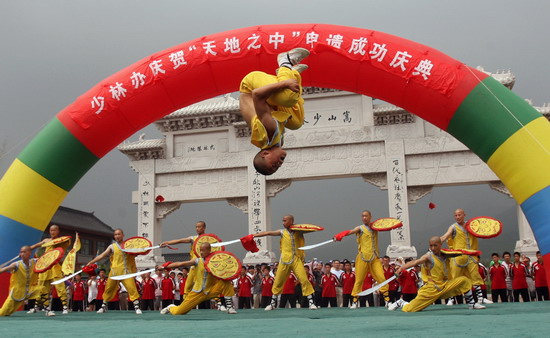Shaolin Temple kicks its way into UNESCO heritage list
Home of Chinese Kung Fu and Zen Buddhism, China' s Shaolin Temple is now part of humanity' s cultural heritage, UNESCO has announced.

The historical architecture complex in central China' s Henan Province, which invokes a sense of mystery and awe, was added Sunday morning (Beijing time) to the World Cultural Heritage List during the 34th session of the World Heritage Committee in Brasilia, Brazil.
UNESCO said the monument stands out for its great aesthetic beauty and its profound cultural connotation.
Nestled in the Songshan Mountains of Dengfeng City, Henan Province, the complex is composed of 11 traditional structures, including Shaolin Temple,the Observatory, Songyang Academy, Taishi Towers, and Zhongyue Temple.
With a history of more than 2000 years, these monuments feature various architectural styles brimming forth with a longstanding heritage of ancient Chinese culture.
It provides the world with a glimpse into the ancient Chinese religion, philosophy, customs, and scientific development, according to Yang Huancheng, a famous ancient architecture expert.
Abbot of Shaolin Temple, Shi Yongxin, said the UNESCO decision is both a privilege and adds pressure.
"For the monks, living in a world-recognized heritage site is a wonderful experience, but at the same time, our responsibility to protect the temple becomes even graver." he said.
Built during the Northern Wei Dynasty (495 AD) by a monk from India, Shaolin Temple boasts a treasure trove of magnificent frescos, tablet inscriptions, and buildings featuring the architectural styles of the Ming and the Qing Dynasties (1368-1911 AD).
The architectural relics are a reflection of the splendid culture of Chinese Kung Fu and Zen Buddhism, Shi said.
Dating back to the early Yuan Dynasty (1271-1368 AD), the observatory at the complex is one of the oldest structures for astronomical observation in the world.
Astronomers at the site were able to calculate the actual length of the year to 365.2425 days, some 300 years before the Europeans had managed to develop the Gregorian calendar.
Built during the Northern Wei Dynasty (386-534 AD), the Songyang Academy was once one of the leading schools for training classical scholars and for spreading Confucianism in Imperial China.
Henan Province began to prepare for the bid to project the Shaolin Temple to the World Heritage Committee nine years ago. The provincial government and Dengfeng municipality have been restoring and upgrading the historical constructions at the site.
The natural environment in that area has also been improved. More than 300 ancient trees have been rejuvenated, according to local authorities.
Local resident, Zeng Jianshu, said, "The success is a tribute for all Chinese people. More tourists will come here in the future, and my business will undoubtedly benefit from the tourist flow."
Though many people hailed the success, there were frowns too with some expressing doubts about the benefits to the area.
A netizen with the surname Mu said the arrival of more tourists may lead to over-commercialization of the site.
"The intrusion of tourists will destroy the tranquility and the sublime beauty of the religious constructions. I' m afraid that the ticket price at the Temple may also go up immediately." Mu said.
Abbot Shi, however, said prices will not rise.
Shi said a higher profile of the Shaolin Temple will heighten the public's awareness to better protect the temple.
"It will also make the Chinese culture better understood by the world." Shi said.
"I' m looking forward to the addition of Shaolin Kung Fu into UNESCO' s intangible heritage list." Shi added.
The architecture complex had applied for inclusion in the world cultural heritage list last year also, but the application was rejected by the committee.
Up to now, China has listed 39 world heritage sites, including 28 cultural heritage sites, seven natural heritage sites and four cultural and natural heritage sites.
 0
0 







Go to Forum >>0 Comments